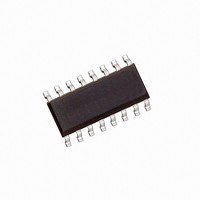HCPL-788J#500 Avago Technologies US Inc., HCPL-788J#500 Datasheet - Page 18

HCPL-788J#500
Manufacturer Part Number
HCPL-788J#500
Description
OPTOCOUPLR AMP CURR SENSE 16SMD
Manufacturer
Avago Technologies US Inc.
Type
Current Sensorr
Datasheet
1.HCPL-788J-000E.pdf
(20 pages)
Specifications of HCPL-788J#500
Voltage - Isolation
3750Vrms
Input Type
DC
Voltage - Supply
4.5 V ~ 5.5 V
Operating Temperature
-40°C ~ 85°C
Mounting Type
Surface Mount
Package / Case
16-SOIC (0.300", 7.5mm Width)
Package Type
SOIC
Operating Supply Voltage (typ)
5V
Lead Free Status / RoHS Status
Contains lead / RoHS non-compliant
Available stocks
Company
Part Number
Manufacturer
Quantity
Price
Frequently Asked Questions about the HCPL-788J
1. The Basics
2. Sense Resistor and Input Filter
18
1.1: Why should I use the HCPL-788J for
1.2: What is the purpose of the V
1.3: What is the purpose of the rectified
2.1: Where do I get 10 mΩ resistors? I
2.2: Should I connect both inputs
2.3: How can I avoid false tripping of the
2.4: Do I really need an RC filter on the
2.5: How do I ensure that the HCPL-788J
sensing current when Hall-effect
sensors are available which don’t
need an isolated supply voltage?
input?
(ABSVAL) output on pin 13?
have never seen one that low.
across the sense resistor instead of
grounding V
fault output due to cable capacitance
charging transients?
input? What is it for? Are other values
of R and C okay?
is not destroyed as a result of short
circuit conditions which cause
voltage drops across the sense
resistor that exceed the ratings of
the HCPL-788J’s inputs?
IN-
directly to pin 8?
REF
Historically, motor control current sense designs have required trade-offs between
signal accuracy, response time, and the use of discrete components to detect short
circuit and overload conditions. The HCPL-788J greatly simplifies current-sense designs
by providing an output voltage which can connect directly to an A/D converter as well
as integrated short circuit and overload detection (eliminating the need for external
circuitry). Available in an auto-insertable, SO-16 package, the HCPL-788J is smaller
than and has better linearity, offset vs. temperature and Common Mode Rejection
(CMR) performance than most Hall-effect sensors.
The V
supply voltage (V
788J is the output full scale range divided by 504 mV.
When 3 phases are wire-ORed together, the 3 phase AC currents are combined to
form a DC voltage with very little ripple on it. This can be simply filtered and used
to monitor the motor load. Moderate overload currents which don’t trip the FAULT
output can thus be detected easily.
Although less common than values above 10 Ω, there are quite a few manufacturers
of resistors suitable for measuring currents up to 50 A when combined with the HCPL-
788J. Example product information may be found at Vishay’s web site (http://www.
vishay.com) and Isotek’s web site (http://www.isotekcorp.com).
This is not necessary, but it will work. If you do, be sure to use an RC filter on both pin
1 (V
In PWM motor drives there are brief spikes of current flowing in the wires leading to
the motor each time a phase voltage is switched between states. The amplitude and
duration of these current spikes is determined by the slew rate of the power transis-
tors and the wiring impedances. To avoid false tripping of the FAULT output (pin 14)
the HCPL-788J includes a blanking filter. This filter ignores over-range input conditions
shorter than 1 μs. For very long motor wires, it may be necessary to increase the time
constant of the input RC antialiasing filter to keep the peak value of the HCPL-788J
inputs below ±230 mV. For example, a 39 Ω, 0.047 μF RC filter on pin 1 will ensure that
2 μs wide 500 mV pulses across the sense resistor do not trip the FAULT output.
This filter prevents damage from input spikes which may go beyond the absolute
maximum ratings of the HCPL-788J inputs during ESD and other transient events. The
filter also prevents aliasing of high frequency (above 3 MHz) noise at the sampled
input. Other RC values are certainly OK, but should be chosen to prevent the input
voltage (pin 1) from exceeding ±5 V for any conceivable current waveform in the sense
resistor. Remember to account for inductance of the sense resistor since it is possible
to momentarily have tens of volts across even a 1 mΩ resistor if di/dt is quite large.
Select the sense resistor so that it will have less than 5 V drop when short circuits
occur. The only other requirement is to shut down the drive before the sense resistor is
damaged or its solder joints melt. This ensures that the input of the HCPL-788J cannot
be damaged by sense resistors going open-circuit.
IN+
REF
) and pin 2 (V
input establishes the full scale output range. V
DD2
IN-
) or a voltage between 4 V and V
) to limit the input voltage at both pads.
DD2
. The nominal gain of the HCPL-
REF
can be connected to the



















